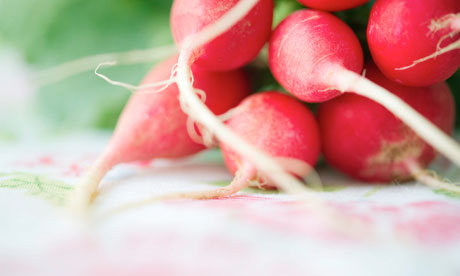
New-season radishes make perfect springtime finger food. Their colours alone lift the spirits, running from white, through blushing pink and scarlet to imperial purple. Globular or elongated and manageably small, you can pop them in your mouth for a juicy crunch with a kick of mustardy heat that makes them a great foil for dips and salty charcuterie.
Buy them small – too big and they become too fibrous and peppery – and, if possible, with the leaves standing to attention. Then you know they are ultra-fresh with the necessary crunch. The leaves needn't be wasted; use them to lend heat to a salad or soup.
Why are radishes good for me?
Like other vegetables of the brassica family (cabbage, broccoli, brussels sprouts etc), radishes contain two natural compounds, sulforaphane and indole-3, which in animal and lab studies have shown an anti-cancer action. It is thought that these antioxidant substances may slow or stop the growth of several different types of cancer, possibly by prompting the body to make higher levels of detoxifying enzymes. Since we generally eat radishes raw, we benefit from this nutritional benefit as these compounds are depleted by cooking. Radishes also give you a significant amount of vitamin C to boost your defences against disease.
Where to buy and what to pay
Farmers' markets and organic box schemes sell interesting varieties (rainbow, black Spanish, purple plum) of small radish in leafy bunches, for around £1 for a small bunch. Supermarkets don't stock the same diversity. The round, de-leafed, red globe‑type radishes in supermarkets are £2.50-£3 a kilo – more for the French breakfast variety.
• Joanna Blythman is the author of What To Eat (Fourth Estate, £9.99). To order a copy for £7.99 with free UK p&p, go to guardianbookshop.co.uk
Roasted radishes with dukkah dip
Dukkah is an Egyptian blend of nuts, seeds and spices. Used like a dry dip, it goes very nicely with these slightly caramelised radishes. Serve this dish as part of a selection of small plates, such as soft-boiled quail eggs, grilled flatbread with olive oil, some quartered little gem lettuces dressed with golden fried garlic slices, lightly pickled carrots and turnips, and hummus. These radishes would also make a great accompaniment to barbecued meat.
For the radishes
1 bunch radishes, washed and trimmed
1 tbsp olive oil
Salt
A squeeze of orange or lemon juice
For the dukkah
3 tbsp coriander seeds
1 tbsp cumin seeds
1 tsp fennel seeds
75g hazelnuts, toasted, skins removed
1 heaped tbsp pumpkin seeds, lightly toasted
1 tsp paprika
75g sesame seeds, toasted until golden
Salt
1 Preheat the oven to 210C/425F/gas mark 7. Make sure the radishes are dry, then toss them in the olive oil and some salt. Put them into a roasting tin and cook for about 15 minutes, until they have started to soften a little and take on a bit of colour.
2 In the meantime, make the dukkah. Heat the coriander, cumin and fennel seeds together in a frying pan and toast until they start to pop, take out immediately and spread on a tray to cool quickly.
3 Chop the hazelnuts and pumpkin seeds finely. Crush the coriander, fennel and cumin seeds in a pestle or a spice grinder until coarsely powdered.
4 In a bowl, combine the hazelnut mixture, the ground spices, paprika, sesame seeds and salt, mix well.
5 When ready, remove the radishes from the oven and squeeze orange or lemon juice on top. Serve immediately, dipped in the dukkah. The mix keeps well if stored in a jar and can be used as a seasoning or in marinades.
• Rosie Sykes is head chef of Fitzbillies and co-author of The Kitchen Revolution (Ebury Press, £27.50). To order a copy for £19.99 with free UK p&p, go to guardianbookshop.co.uk

